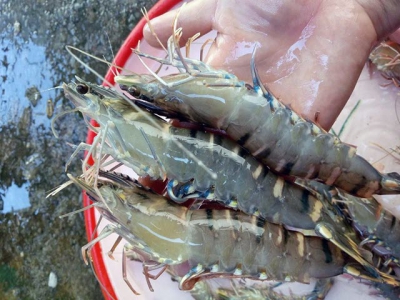Farmers prefer merchants to shrimp trading floor

The first shrimp trading floor has been put into operation which allows buyers and sellers to conduct transactions directly, without intermediaries. However, no one believes the model will succeed.
At present, farmers mostly sell shrimp to merchants or collection agents who will re-sell to processing companies and exporters. Merchants come to shrimp ponds, collect shrimp samples, assess the quality, fix prices and set the time of harvesting.
Processing companies do not have manpower to come directly to shrimp ponds to collect materials, while farmers don’t want to sell shrimp directly to processors because they don’t know how the buyers assess their products. If transactions between farmers and processors don’t succeed, farmers cannot bring the harvested shrimp back to the ponds.
The inborn problem of the trading model is that farmers cannot connect directly with those who have demand. As a result, farmers have to sell shrimp at low prices, while exporters cannot find shrimp supplies to gather materials to fulfill export contracts.
The inborn problem of the trading model is that farmers cannot connect directly with those who have demand. As a result, farmers have to sell shrimp at low prices, while exporters cannot find shrimp supplies to gather materials to fulfill export contracts.
Nguyen Manh Trieu, deputy chair of Cuu Long Technology and Investment JSC, which is running the first shrimp trading floor, affirmed that the trading floor will settle the existing problems.
Farmers now can refer to the information about the buy/sell prices of successful transactions before placing orders and place orders at any time.
“The shrimp trading floor ensures high liquidity because information about the sale is provided nationwide,” he said.
However, farmers are reluctant to use the new trading method.
“How will the trading floor replace the works being undertaken by merchants? Will the trading floor send officers to shrimp ponds to collect samples and assess quality? What will happen if the shrimp quality is not as high as declared?” said Chau Trung Truc, director of Doan Ket Seafood Cooperative in Ca Mau province.
Tried said when putting shrimp for sale on the trading floor, sellers will have to provide information about product quality and buyers will come to examine the quality.
“If buyers discover that the declared quality is not the same as the quality of products in reality, they will have the right to cancel contracts and the credit rating of sellers will be lowered,” Trieu replied.
However, Trieu’s explanation cannot satisfy businesses. Director of a shrimp export company said his company doesn’t have enough workers to send to localities to examine the quality of shrimp before bringing shrimp to processing workshops. The work is now undertaken by merchants.
Nguyen Quang BInh, director of CTA, also said both buyers and sellers face high risks.
“The trading scheme could be effective to buyers and sellers who are near each other, but will be a problem if the seller is in Nha Trang and buyer in Ca Mau,” he commented.
Related news
 Catfish exports to China and US down, Vietnam puts hope on EU market
Catfish exports to China and US down, Vietnam puts hope on EU market The catfish consumption level from the two biggest markets, China and the US, unexpectedly fell in Q1.
 Agriculture sector needs to build value chains
Agriculture sector needs to build value chains Building agro-forestry-fishery high value chains is crucial for the sustainable development of the agriculture sector in the context of international
 Cà Mau eyes expansion of efficient farming, forestry models
Cà Mau eyes expansion of efficient farming, forestry models The Cửu Long (Mekong) Delta province of Cà Mau is expanding all its efficient agriculture, fishery and forestry models.